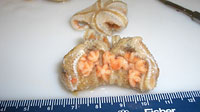

 | |||||||||||||||||||||||
|
|
Journals 2008/2009Roy Arezzo
July 27, 2008 Today was a wash out, literally. With winds up to 40 plus knots we were unable to deploy the Megacore. We worked through the night to finish up trawling and saved the Megacore sampling in the hopes the weather would let up. Instead, the winds picked up resulting in all deployments being placed are on hold for the time being. Although there are high seas causing the ship to roll, the real issue is the pitch between bow to stern, which can jostle the cable, altering the tension on the line. Instruments like the Megacore and the Time Lapse Camera have too many sensitive parts and require a smooth touchdown to risk have them bounced off the bottom. We are still ahead of schedule and can afford a delay and prefer not to risk damaging the Megacore.
There is talk of visiting Palmer Station until the storm passes but getting into their small dock with this large of a ship is tricky. Reports of winds over 60 knots near the station suggest it is unlikely that we will be able to visit land today. The only option we have is to steam a few miles with the wind and then back against it to remain in the vicinity of the station until weather improves. We are all on hold and trying to catch up with storing samples and email. Since I was not needed on deck I was trained on another species for dissection. I found the sea pigs to be a little easier than Peniagone despite the fragile walls of the gut. I hope to graduate to sea urchins (said to be the most difficult dissection) before the end of the trip. I also had some time in the Bio Lab to examine some of the specimens being looked at for DNA and recruitment. Many of the organisms seem to reproduce year-round. The images of trawl specimens below show evidence of recruitment.
On a lighter note, Christian, an undergraduate student from the University of Hawaii, celebrated a birthday at sea today. Last night, after midnight, when Christian came on watch we did chocolate milk shots in the Dry Lab (no pun intended) to toast his 21st birthday.
|
||||||||||||||||||||||




